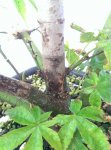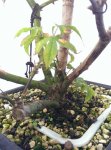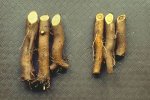fredman
Masterpiece
I did a layer on this JM osakazuki this season, but now I'm worried the dieback might kill off the whole tree. It seems to have stopped above the new growth but on the one side it looks like its continuing down. I don t mind the loss of the two branches as I will be rebuilding it in any case. I just need the dieback to stop right where it currently is....!!!
What should I do? Winter is approaching here and I fear it might get worse. Do I leave it and hope for the best? Do I remove those two branches and treat with something?
I'm currently feeding it ferociously to try and strengthen it, so it can fight the dieback...
This is a view from the one side.

This from the opposite side

It seems to growing fairly strongly as it even has a seed pod and flowers on it. Maybe its just confused...
Here is some more pics...




What should I do? Winter is approaching here and I fear it might get worse. Do I leave it and hope for the best? Do I remove those two branches and treat with something?
I'm currently feeding it ferociously to try and strengthen it, so it can fight the dieback...
This is a view from the one side.

This from the opposite side

It seems to growing fairly strongly as it even has a seed pod and flowers on it. Maybe its just confused...
Here is some more pics...











